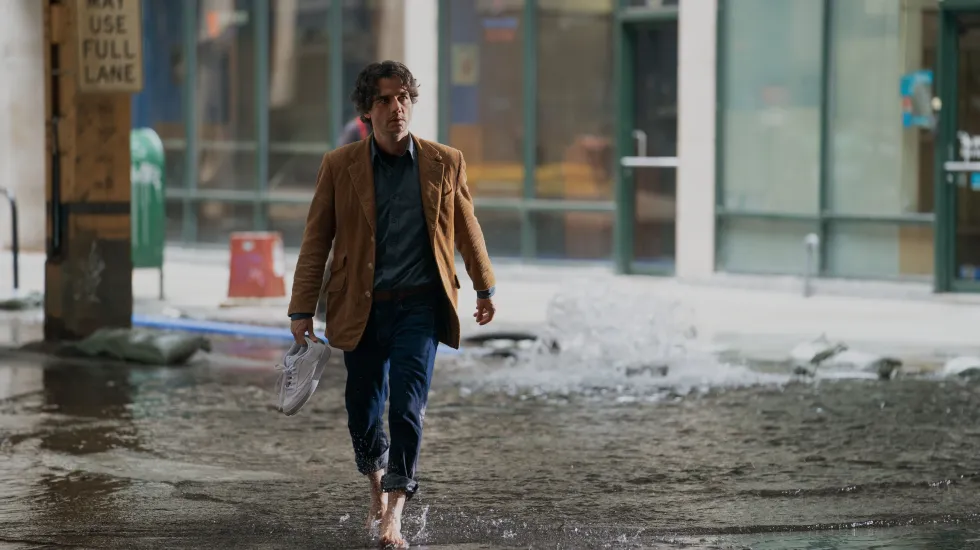
Whenever your profession is showcased in a movie or on a TV show, it’s impossible not to notice what is accurate and what would NEVER happen. Whether you’re a cop or a construction worker, a lawyer or a pharmacist, a farmer or a chemist—doesn’t matter. You’ll be watching this movie or that show, and you’ll nod in recognition at the moments of accuracy, and howl in derision when they fly off the rails in the name of poetic license.
In the elegantly constructed, hauntingly memorable and beautifully filmed new Apple TV+ series “Shining Girls,” series executive producer, sometimes director and star Elisabeth Moss plays one Kirby Mazrachi, an archivist at the Chicago Sun-Times in the early 1990s—and as someone who was working as a reporter and columnist at the Sun-Times at that time, I was left mesmerized at how the production team expertly, dare I say perfectly, captured the very essence of the paper in that era.
They got it right, from the newsroom with its metal desks and clunky computers and piles of notebooks and papers to the printing press and of course the marvelously ugly, barge-like Sun-Times Building on Wabash Avenue along the Chicago River, which as been digitally restored. (Sorry, Trump Tower.)
An eight-episode series debuting with three episodes Friday. A new episode will premiere on each subsequent Friday.
They also get the details of reporting right, not to mention the atmosphere at the morning news meetings, when the editors hear what’s happening and start the process of deciding of what goes on the front page, what gets buried, what can be dropped in the interest of space. Granted, even if this sometimes convoluted, mind-bending, noir-leaning series had fumbled the ball in depicting newspaper journalism circa 1992, it wouldn’t have meant an automatic negative review—but the meticulous attention to detail on display in the newspaper scenes carries throughout this eight-part series, which was adapted by Silka Luisa from the best-selling and acclaimed novel of the same name by Lauren Beukes.

Wearing Walkman headphones and keeping her head down, Kirby is an almost invisible figure at the Sun-Times, pulling clippings for the reporters who are bustling about the newsroom as she avoids interaction as much as she can—until she hears about cityside reporter Dan Velazquez (Wagner Moura) getting a scoop about a dead body that was found in a pipe in Chicago’s labyrinthine underground tunnels in the immediate aftermath of the Great Chicago Flood of 1992 (a real thing that happened when bridge repair workers accidentally breached the wall of an abandoned utility tunnel, flooding the Loop with millions of gallons of water and causing billions in damages). When Kirby learns certain gruesome details about the murder, she’s convinced the individual who killed this poor woman is the same monster who attacked Kirby a few years earlier as Kirby was walking her dog along the lake, leaving her torso cut open and placing a certain object inside her.

Kirby miraculously survived the attack—but ever since then, things have been … off, as if she’s caught in some kind of multiverse existence where only she recognizes when things have changed. She lives with her mother, a hard-partying, middle-aged rocker named Rachel (Amy Brenneman), along with her cat, Grendel. Until the next day, when Kirby lives alone, her mother is a born-again Christian, and Grendel is now a big dog. In yet another slice of Kirby’s life, she’s living in a different place, and she’s married to Marcus (Chris Chalk), a Sun-Times photographer. To say Kirby is an Unreliable Narrator is putting it mildly—and when she teams up with Dan to investigate what could be a string of murders of young Chicago women, spanning decades, well, Dan’s not exactly the most dependable sort either, as he has a history of blackout drunk episodes.
Moving at a pace that is admittedly a bit deliberate at times, “Shining Girls” establishes from its opening scene that Jamie Bell’s Harper, a mysterious drifter, is the personification of pure evil and has an unnerving knack for showing up out of thin air to toy with possible victims, not to mention an almost supernatural ability to see the future. (A scene in which a potential victim keeps discovering Polaroids of her doing things she’s about to do is masterful.) This is all about the hows and the whys of the murders, and there are times when it feels as if the more Kirby knows, the less we know. We’ll not give away any more than that, other than to say the payoffs in “Shining Girls” are well worth the time investment.
Moss is magnificent playing a woman whose life (lives?) has been stolen but refuses to be a victim. Wagner Moura is the quintessential Ink- and Booze-Stained Wretch. Libertyville’s own Phillipa Soo (“Hamilton”) has some terrific showcase moments as an astronomer at the Adler Planetarium who is on Harper’s radar.
The acting is sublime. The writing is outstanding. And the Chicago Sun-Times of the early 1990s takes a triumphant victory lap.







